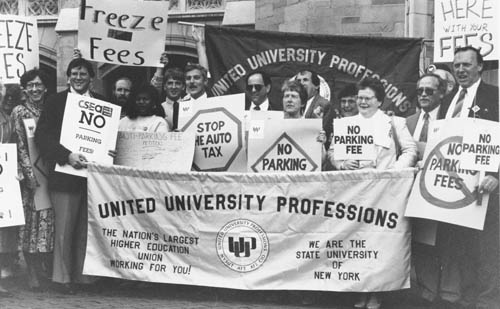Source: AFL-CIO
Make No Mistake
Unions Make a Difference
Higher Wages
Unionized workers in the U.S. earn an average of 27% more than nonunion workers.
Paid Sick Leave
83% of union workers have paid sick leave, compared with just 62% of nonunion workers.
Health Insurance
79% of union workers receive health benefits. Only 49% of nonunion workers can say the same.
Retirement
76% of union workers have company pensions. Just 16% of nonunion workers enjoy the same benefit.
Have you signed your UUP membership card?
The Nation's Largest Higher Education Union
About UUP
History of UUP

Photo from the UUP archive.
Determined to Have a Voice
United University Professions (UUP) was founded in 1973 by university professionals determined to have a voice on things like workplace safety, policies, wages and benefits. They knew their greatest strength was in their numbers, and banded together with an initial membership of 3,500.
In the more than four decades since, United University Professions has grown exponentially, becoming America’s largest higher education union. More than 35,000 members strong, UUP is a powerful ally for university professionals, demanding respect and fair treatment with the voice of thousands.
UUP is a unified voice, protecting members rights at the bargaining table and on the job. The union also speaks on behalf of public higher education statewide, nationally and internationally. UUP is the voice of SUNY’s academic and professional employees to the SUNY Board of Trustees, SUNY System Administration, the state’s elected officials and the public. UUP is also affiliated with New York State United Teachers and the American Federation of Teachers, the National Education Association and the AFL-CIO.
About UUP
Former U.S. Secretary of Labor Robert Reich explains the importance of unions.
UUP Exists for Your Benefit
United University Professions (UUP) fights for competitive salaries, health benefits, job security, workplace safety and fair treatment for its members. It is the only organization designated to negotiate with New York State on behalf of SUNY’s academic and professional employees.
Without the negotiating power forged by tens of thousands of united workers, UUP members would have very little, if any, say on the terms and conditions of their employment. In short, they would be powerless to affect how they’re treated and compensated – and would simply have to hope for the best.
The Case for Unions
On average, non-union workers earn significantly less, receive fewer benefits, and enjoy less job protection than union workers (AFL-CIO). In August 2016, a report from the Economic Policy Institute concluded that stagnating wages and rising income inequality across the country can be directly correlated with a decline in union membership.
Hero image photo credit: Keith Walters